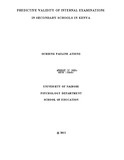| dc.description.abstract | This study sought to establish the relationship between performance in internal (teachermade)
summative examinations and external summative public national examination. The
objectives were to establish whether there is significant relationship between internal
summative examination and external summative examination in secondary schools in
Kenya, determine which subject has a greater capacity in predicting performance in
external summative examination (KCSE), and the year with more weight in predicting
performance in external summative examinations.
This study adopted a descriptive research design. The target population of the study
comprised of all the students from four secondary schools who registered in Form 1 in
2007 and sat for their KCSE examination in 2010.Examination scores for internal
summative examinations and KCSE examination scores for 60 students from form 1 in
2007 to form four in 2010 were purposively sampled from each of the four schools
targeted making a sample of 240 students. The instrument used to collect data was an
inventory. The inventory requested test scores derived from tests constructed,
administered, and scored by teachers in secondary schools for Maths, English, Biology
and Geography. Data was analysed using quantitative statistics. The relationship between
the scores was determined by calculating correlation coefficient and results presented
using tables and graphs with the aid of SPSS.
The study revealed that there is significant relationship between the internal summative
examination scores and the external public summative examination scores with
mathematics as a major predictor of student performance and that the students
performance in the internal summative examination in first year cannot be used to predict
the performance in the external summative examination. Fourth year is a major predictor
followed by the performance in third year and then finally the performance in second
year. The study recommends that the Kenya National Examination Council should
standardise the internal summative examination conducted by teachers in their respective
schools and that the student examination scores in the internal summative examination to
be used to award students incase a student is unable to sit for external summative
examination due to unavoidable situations. | en_US |



